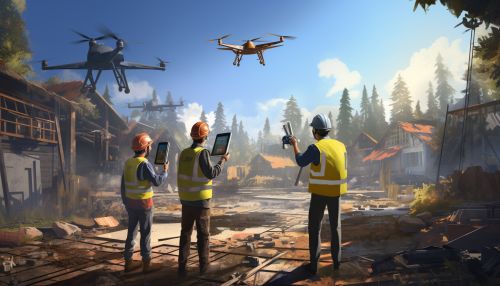Geotechnical engineering
Overview
Geotechnical engineering is a subfield of civil engineering that deals with the behavior of earth materials and the application of the principles of soil mechanics and rock mechanics. It is used in the analysis and design of foundations, slopes, retaining walls, embankments, tunnels, levees, wharves, landfills, and other systems that are made of or are supported by soil or rock.


History
The field of geotechnical engineering has its roots in the works of early engineers such as Henry Darcy and Karl Terzaghi, who made significant contributions to the understanding of soil mechanics. The modern discipline of geotechnical engineering emerged in the late 19th and early 20th centuries with the development of systematic testing methods for soil properties and the application of these methods to practical engineering problems.
Soil Mechanics
Soil mechanics is a fundamental aspect of geotechnical engineering. It involves the study of the physical properties of soils and the behavior of soil masses subjected to various types of forces. Soil mechanics includes the study of soil composition, fluid flow through soil, shear strength of soil, compressibility and consolidation of soil, and soil plasticity.


Rock Mechanics
Rock mechanics, another crucial part of geotechnical engineering, focuses on the behavior of rock masses. It includes the study of rock deformation, fracture, and flow characteristics. Rock mechanics is particularly important in the design and construction of tunnels, mines, and dams, and in the assessment of slope stability and the stability of rock structures.
Site Investigations
Site investigations are a critical part of geotechnical engineering. They involve the collection of data about the physical properties of soil and rock at a specific site, which is then used to design and construct structures. Site investigations typically include soil sampling, laboratory testing of soil samples, and geophysical testing.


Geotechnical Design
Geotechnical design involves the application of geotechnical engineering principles to the design of structures. This includes the design of foundations for buildings and bridges, the design of retaining walls and slopes, the design of tunnels and dams, and the design of landfills and other waste disposal facilities.
Geotechnical Construction
Geotechnical construction involves the application of geotechnical engineering principles to the construction of structures. This includes the construction of foundations, retaining walls, slopes, tunnels, dams, and landfills. Geotechnical construction often involves the use of specialized construction techniques and equipment.


Challenges and Future Directions
Geotechnical engineering faces several challenges and future directions, including the need for sustainable and resilient design, the impact of climate change on geotechnical systems, and the integration of new technologies and materials.
